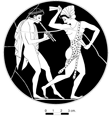
Side A: Herakles and Busiris
[Image not available]
Three-dimensional approximation of the vase

Side B: Banquet scene
| Collection: | London, British Museum |
| Summary: | Side A: Herakles and Busiris. Side B: Banquet scene. Interior: Man with flute and dancing girl in leopard skin. |
| Ware: | Attic Red Figure |
| Painter: | Signed by Epiktetos |
| Potter: | Signed by Python |
| Context: | From Vulci |
| Date: | ca. 520 BC - ca. 510 BC |
| Dimensions: | H. 0.123 m. |
| Primary Citation: | |
| Shape: | Kylix |
| Beazley Number: | 200460 |
| Region: | Etruria |
| Period: | Archaic |
Decoration Description:
Side A: Herakles, Busiris, and four Egyptian attendants. In the center of the scene stands Herakles. He wears a lion skin and short chiton, and a quiver hangs at his left side. He is bending forward to grab Busiris by the arm, while he raises his club with his right hand to hit him. Busiris lies cringing on the ground before the altar. He raises both hands in supplication, and he is bleeding from his cheek and head. To the left, two attendants run away from the scene, looking back over their shoulders. The furthest one carries the makhaira or sacrificial knife, while at his feet is the kaneon (offering basket). Next to him, the other servant wears a mouthpiece for the flute, and is carrying the flute case on his back. On the right hand side, two more servants run away, and also look back. The furthest one has apparently dropped a cithara, which lies on the ground at his feet. Next to him, the other servant is carrying an oinochoe. The Egyptians (including Busiris) wear chitons and wreaths; their heads are shaven and their features very Nubian. Above the scene is the inscription
This scene relates the story of the death of the Egyptian king Busiris, who was told by the Cypriot prophet, Phrasius, that in order to stop the famine in the land he would have to sacrifice all strangers entering the kingdom. After sacrificing the first stranger (Phrasius himself) Busiris attempted to kill Herakles, who broke lose from his bonds and killed the king instead.
Side B: Symposion or banquet scene. On the left stands an auletrix (flute player). She wears a scarf covering her hair, earrings, and a chiton and peplos. Before her, a bearded man reclines on his left elbow on a dining couch, his left hand casually draped over the side. He flings his head back, and supports it with his right hand bent behind his neck. His drinking cup sits on the ground in front of the flute girl. To the right stands a nude boy holding an oinochoe, with which he fills the drinking bowl of the second banqueter. This man is balding, and has a scarf tied around his forehead like a fillet. He holds a kylix out to the boy with his right hand, while extending his left hand toward him. The boy is touching the man's left arm (perhaps to hold him off?). At the far right, a third banqueter is shown from the back; only the head of his dining couch is visible. He too is reaching out with his drinking cup for the boy to give him more wine. Above their heads is the inscription
Int.: A flute player with double flutes plays for a dancing woman (maenad or hetaira). She is holding krotala (something like castanets), and dancing wildly; she wears a scarf in her hair, a very short chiton with embroidered border, and a panther skin. The flute player is beardless, and he is nude except for a chlamys flung over his far shoulder. He seems to be beating the time of the music with his left foot.
Epiktetos also painted a very early kylix in the Museum of Art, Rhode Island School of Design (
Inscriptions:
Side A:
Sources Used:
RA 1 (1988): 109-118, fig. 3.
Other Bibliography:
RA 2 (1982) 215 fig. 14L'Instrument de Musique dans la céramique de la grèce antique, Etudes d'organologie Paris, 1984


